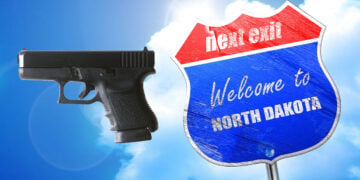We all may face a time in life where we are disabled to some extent. Perhaps a health issue or an accident leaves us recovering. Perhaps we face a permanent disability. Some struggle with a disability their entire life. The reality is, most of us will face at least some point in our life when we are recovering and not at our full physical capacity. Have you ever wondered how this would factor into self-defense? What if you were in need of surgery to fix a pressing medical need or to repair damage from an accident. How might this compromise your current function? What if you have to recover from injury to a leg, a hip, an arm? How would that influence your current lifestyle of carrying tools and building skills for personal protection?
Many possible scenarios would reduce our capacity, at least for a temporary time, and some ingenuity can allow us to continue to carry and utilize defensive tools. In particular, the concealed carry handgun that we use, and the way in which we carry it, might have to change to accommodate the new circumstances. If you sustain an injury to your lower body and your ability to walk is compromised, the way you carry a handgun may need to change. If you lose the use of one arm, you obviously may need to change your carry mode. Dominant hand is out of commission? You may need to switch to carrying accessible to your support-hand side. Likewise, the gun that you currently use may simply not be optimal due to a physical injury or other limitation.
Relying on the Support Hand Only
To prepare for such a possibility, it makes sense to spend some time considering this beforehand. One of the most important ways to do this is to become proficient shooting with only your support hand. This is, of course, something that you should work on anyway. The possibility of sustaining the loss of your dominant hand during a fight is there. But in the event of having to overcome an injury to your dominant hand, those skills will also serve well.
Support Hand Accessibility
Beyond just shooting with your support hand, however, consider actually carrying a gun accessible to your support hand. You might wonder why you would do that under normal circumstances, but becoming familiar with such a setup could prove beneficial in other ways. An excellent way to become acquainted with carrying a gun specifically for the support hand is to set yourself up with it as a backup gun.
You don’t have to carry the second gun on a daily basis. But having such a setup available to you is a good thing, should you be in a situation where adding the second handgun to your carry makes sense. Obviously, if the second gun is carried so that it is oriented to be drawn by the support hand (which should typically be the case for a backup gun anyway), then this will translate well to a situation where your dominant hand is out of commission.
Smaller Gun is an Option
Thinking beyond just the different carry mode, the gun used may be suited to change as well. Realistically, a smaller gun, and perhaps a different kind of gun entirely, may be better for use as a support hand option. Maybe a small fumble-prone revolver, for example, serves best as a backup gun. But then it can also serve well as your temporary primary weapon should you need it during recovery. For example, I like a small-frame revolver tucked into the AIWB position as a backup gun. Though I rarely carry a second gun on a daily basis. Should I be limited to only the use of my support hand, I would simply rely on this gun, in this position, as my primary.
Practice, Practice, Practice
The occasional practice with this dedicated secondary weapon is in order. And you should verify that you can safely draw the gun from this position in dry fire practice first. One reason I like the small revolver is that it proves a very safe design when using with the less practiced support hand from a holster. Consider that. A revolver or other double-action option may prove ideal if you need to carry it on, and draw from, the support side. The accompanying gear that goes along with your gun will also need to change. A reload for the gun will need to be placed where it is accessible. The same thing goes for your knife if a knife is part of your defensive carry. Experimenting with this placement may be worthwhile.
Accommodating Lower Body Limitations
Should you find yourself limited in the lower body, you may need to change your carry methods even if both hands are sound. If you are confined to a wheelchair or the use of crutches for a while, you may find that your usual belt-carried setup is not feasible. A permanent disability will likely lead the individual to find permanent solutions to carry a full kit in some way. Many people who use wheelchairs go well-armed. However, a temporary limitation may see the need for a temporary solution. And scaling back on what you carry may be in order. If using a wheelchair, you may find that appendix position carry works much better than does strong-side-hip carry. Pocket carry is entirely difficult when in a seated position. However, when seated, ankle carry becomes quite feasible even though it poses challenges when on foot.
The use of crutches may pose challenges, as well. Your usual handgun and other gear may simply be problematic on your waistline, depending on the injury. While I generally dislike the use of a shoulder holster for any reason, this may be an exception. Likewise, I recommend against carrying a gun in any cross-draw fashion. It proves a very easy draw to block at contact distance. But if you need to get around on crutches, it may prove more accessible than a strong-side gun. While the consistency of carry mode is essential most of the time, accommodating an injury is an obvious exception. Having a safely carried, yet slower to access, handgun on your person is undoubtedly better than going unarmed.
Conclusion
Like all else in the realm of personal protection, considering these possibilities is an exercise in preparation. It may not be the highest level of priority in your shooting. But should you become physically limited for some time, this forethought may prove quite valuable.









